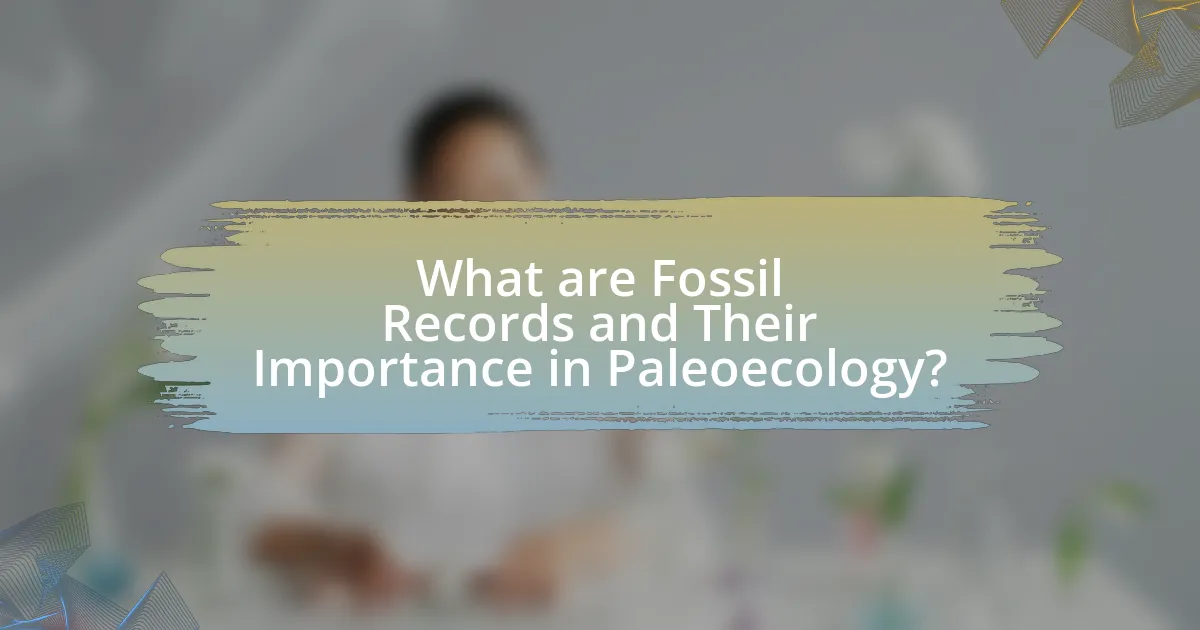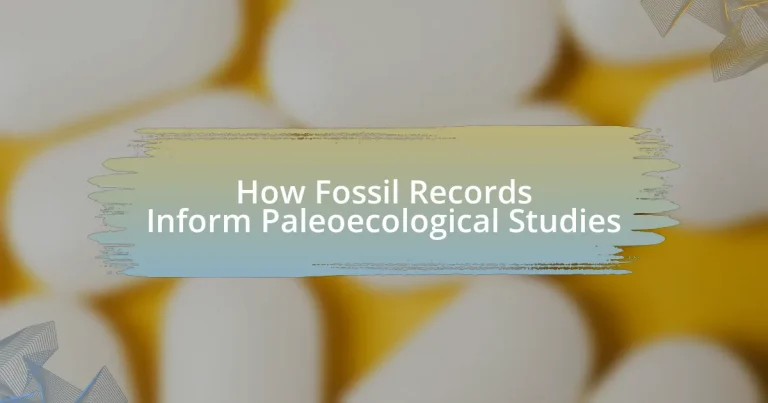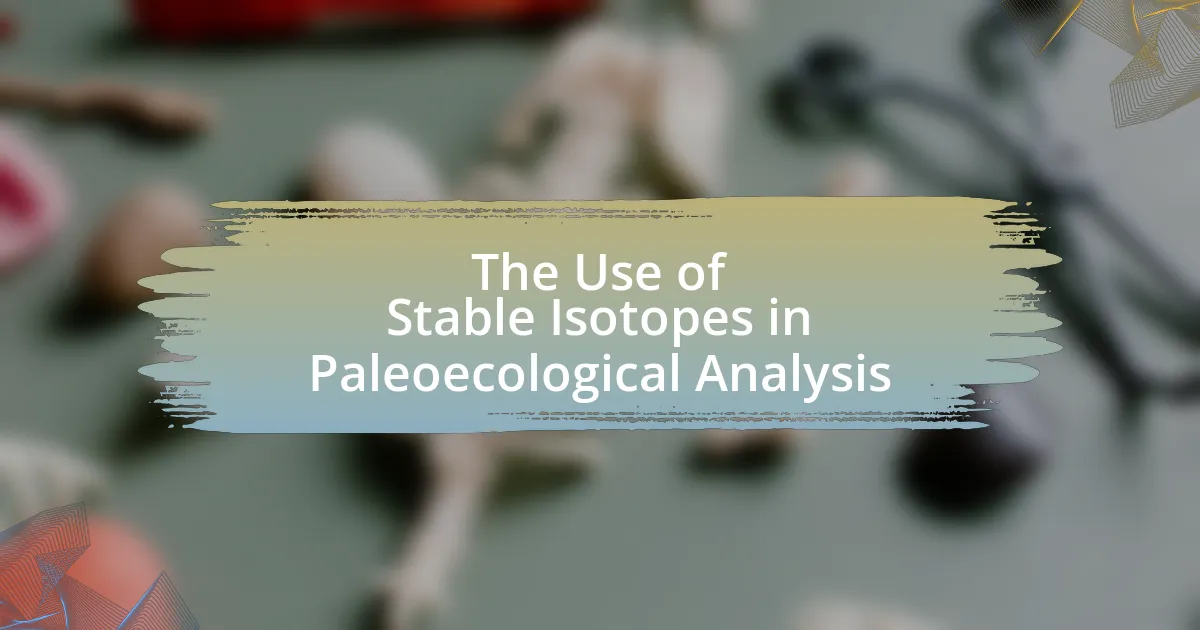Fossil records are the preserved remains or traces of ancient organisms found in sedimentary rocks, playing a crucial role in paleoecology by providing evidence of past life forms and their environments. This article explores how fossil records contribute to understanding ancient ecosystems, species interactions, and changes in biodiversity over geological time. It discusses the types of information gleaned from fossil records, their significance in reconstructing past climates, and their role in biodiversity assessments and evolutionary studies. Additionally, the article outlines methods for collecting and analyzing fossil records, the insights they provide about species interactions and extinction events, and best practices for ensuring accurate interpretations in paleoecological research.

What are Fossil Records and Their Importance in Paleoecology?
Fossil records are the preserved remains or traces of ancient organisms found in sedimentary rocks, providing crucial evidence of past life forms and their environments. These records are essential in paleoecology as they allow scientists to reconstruct ancient ecosystems, understand species interactions, and track changes in biodiversity over geological time. For instance, fossilized pollen can reveal past climate conditions and vegetation types, while vertebrate fossils can indicate predator-prey relationships. The analysis of these records contributes to our understanding of evolutionary processes and the impact of environmental changes on life, thereby validating their significance in the study of historical ecology.
How do fossil records contribute to our understanding of ancient ecosystems?
Fossil records provide critical insights into ancient ecosystems by revealing the types of organisms that existed, their interactions, and the environmental conditions of their habitats. These records, which include preserved remains, traces, and imprints of organisms, allow scientists to reconstruct past biodiversity and ecological dynamics. For example, the discovery of fossilized plants and animals in specific sedimentary layers indicates the climate and geographical conditions at the time, such as temperature and moisture levels. Additionally, isotopic analysis of fossils can inform researchers about ancient food webs and trophic interactions, illustrating how species adapted to their environments. Thus, fossil records serve as a vital tool for understanding the complexity and evolution of ecosystems over geological time.
What types of information can be gleaned from fossil records?
Fossil records provide critical information about past life forms, their environments, and evolutionary processes. They reveal details such as the morphology of extinct species, their distribution across different geological periods, and the ecological interactions they had with other organisms. For instance, the presence of specific fossils in certain strata can indicate the climate conditions of that era, as seen in the discovery of marine fossils in now-dry regions, which suggests historical sea levels. Additionally, isotopic analysis of fossils can inform scientists about ancient diets and habitats, further enhancing our understanding of paleoecological dynamics.
How do fossil records help in reconstructing past climates?
Fossil records help in reconstructing past climates by providing evidence of ancient organisms and their environments, which reflect the climatic conditions of their time. For instance, the presence of certain plant fossils, such as ferns, indicates a warm and humid climate, while the discovery of pollen grains can reveal shifts in vegetation types linked to temperature and precipitation changes. Additionally, isotopic analysis of fossilized remains, such as those from marine organisms, allows scientists to infer past ocean temperatures and ice volume, further elucidating climate conditions. These methods collectively enable researchers to create detailed reconstructions of historical climate patterns, supported by specific fossil evidence from various geological periods.
Why are fossil records considered vital for paleoecological studies?
Fossil records are considered vital for paleoecological studies because they provide direct evidence of past life forms and their environments. These records allow scientists to reconstruct ancient ecosystems, understand species interactions, and track changes in biodiversity over geological time. For instance, fossilized remains of plants and animals, along with their isotopic compositions, can reveal climatic conditions and habitat types that existed millions of years ago, thereby offering insights into how ecosystems responded to environmental changes. This information is crucial for understanding the evolutionary history of life on Earth and predicting future ecological shifts.
What role do fossil records play in biodiversity assessments?
Fossil records play a crucial role in biodiversity assessments by providing historical data on species diversity, distribution, and extinction events. These records allow scientists to reconstruct past ecosystems and understand how biodiversity has changed over geological time. For instance, studies of fossilized remains have revealed patterns of species turnover and the impact of environmental changes, such as climate shifts, on biodiversity. Research indicates that fossil records can document mass extinction events, such as the Cretaceous-Paleogene extinction, which eliminated approximately 75% of species, thereby offering insights into the resilience and recovery of ecosystems. This historical perspective is essential for predicting future biodiversity trends in the face of ongoing environmental changes.
How do fossil records assist in understanding evolutionary processes?
Fossil records assist in understanding evolutionary processes by providing tangible evidence of past life forms and their changes over time. These records reveal the morphological characteristics of extinct species, allowing scientists to trace the lineage and evolutionary adaptations of organisms. For instance, the fossilized remains of transitional species, such as Archaeopteryx, demonstrate the evolutionary link between dinosaurs and birds, showcasing features like feathers and a wishbone. Additionally, fossil records help establish timelines for evolutionary events, as seen in the Cambrian explosion, which marks a rapid diversification of life approximately 541 million years ago. This evidence supports the theory of evolution by illustrating how species have adapted to their environments through natural selection and other mechanisms.

How are Fossil Records Collected and Analyzed?
Fossil records are collected through systematic excavation and fieldwork, where paleontologists carefully uncover fossils from sedimentary rock layers. These fossils are then analyzed using various techniques, including radiometric dating to determine their age, morphological analysis to identify species, and isotopic analysis to infer environmental conditions. For instance, the use of carbon dating can provide age estimates for organic materials, while stable isotope analysis can reveal information about ancient climates and diets. These methods collectively enhance our understanding of past ecosystems and the evolutionary history of life on Earth.
What methods are used to collect fossil records?
Fossil records are collected using several methods, including excavation, stratigraphic analysis, and remote sensing. Excavation involves carefully digging at sites where fossils are likely to be found, often in sedimentary rock layers that have preserved biological materials. Stratigraphic analysis helps researchers understand the geological context of fossil deposits, allowing them to date and correlate findings with other sites. Remote sensing techniques, such as aerial photography and satellite imagery, assist in identifying potential fossil-rich areas by revealing geological formations that may contain fossils. These methods are validated by their widespread use in paleontology, where successful fossil recovery has been documented in numerous studies, contributing to our understanding of ancient ecosystems.
How does excavation technique impact the quality of fossil records?
Excavation technique significantly impacts the quality of fossil records by influencing the preservation and context of the fossils recovered. For instance, meticulous excavation methods, such as stratigraphic excavation, allow for the careful removal of sediment layers, which helps maintain the spatial relationships between fossils and their surrounding geological context. This precision is crucial for understanding the paleoenvironment and the biological interactions of the time. Conversely, hasty or indiscriminate excavation can lead to damage or loss of critical information, resulting in poorly preserved fossils that lack contextual data. Studies have shown that well-documented excavation practices enhance the reliability of fossil records, as evidenced by the successful recovery of well-preserved specimens in sites like the Burgess Shale, where careful excavation revealed a wealth of information about Cambrian ecosystems.
What technologies enhance fossil record collection?
Technologies that enhance fossil record collection include 3D scanning, Geographic Information Systems (GIS), and advanced imaging techniques such as X-ray computed tomography (CT). 3D scanning allows for precise digital representations of fossils, facilitating detailed analysis and sharing among researchers. GIS enables the mapping and spatial analysis of fossil locations, improving understanding of paleoenvironments and biogeography. Advanced imaging techniques, like CT, provide non-destructive insights into the internal structures of fossils, revealing anatomical details that are otherwise inaccessible. These technologies collectively improve the accuracy and efficiency of fossil collection and analysis, thereby enriching paleoecological studies.
How is data extracted from fossil records?
Data is extracted from fossil records through various scientific techniques, including stratigraphy, radiometric dating, and paleontological analysis. Stratigraphy involves studying the layers of rock where fossils are found, allowing scientists to determine the relative ages of fossils and the environmental conditions at the time of deposition. Radiometric dating provides absolute ages by measuring the decay of isotopes within the rocks surrounding the fossils. Paleontological analysis includes examining the morphology and distribution of fossils to infer biological and ecological information. These methods collectively enable researchers to reconstruct past ecosystems and understand evolutionary processes, as evidenced by studies that correlate fossil findings with geological events, such as mass extinctions and climate changes.
What analytical techniques are employed in paleoecological studies?
Paleoecological studies employ various analytical techniques, including stable isotope analysis, palynology, and sediment analysis. Stable isotope analysis allows researchers to infer past climate conditions and dietary habits of organisms by examining isotopic ratios in fossilized remains. Palynology, the study of pollen and spores, provides insights into past vegetation and climate changes by analyzing sediment cores. Sediment analysis involves examining the physical and chemical properties of sediment layers to reconstruct environmental conditions over time. These techniques collectively enhance the understanding of historical ecosystems and their responses to climatic shifts.
How do researchers interpret fossil data to draw conclusions?
Researchers interpret fossil data by analyzing morphological characteristics, stratigraphic context, and isotopic compositions to draw conclusions about past life forms and their environments. Morphological analysis involves examining the physical features of fossils to identify species and understand evolutionary relationships. Stratigraphic context provides information about the age and environmental conditions during the time the organisms lived, as fossils are often found in sedimentary layers that reflect specific geological periods. Isotopic analysis helps determine ancient climate conditions and dietary habits by measuring the ratios of stable isotopes in fossilized remains. These methods collectively enable researchers to reconstruct ecosystems, understand biodiversity changes over time, and infer the ecological roles of extinct species, thereby providing a comprehensive view of historical life on Earth.

What Insights Do Fossil Records Provide About Past Life?
Fossil records provide critical insights into past life by revealing the diversity, distribution, and evolution of organisms over geological time. These records allow scientists to reconstruct ancient ecosystems, understand species interactions, and track changes in biodiversity in response to environmental shifts. For instance, the fossilized remains of dinosaurs and plants from the Mesozoic era illustrate the types of species that existed and their adaptations to different habitats. Additionally, isotopic analysis of fossils can indicate past climate conditions, further informing our understanding of how life adapted to changing environments. This evidence supports the theory of evolution and helps scientists predict future biological responses to ongoing climate change.
How do fossil records inform us about species interactions?
Fossil records inform us about species interactions by providing direct evidence of past ecological relationships, such as predation, competition, and symbiosis. For instance, fossilized remains of predator-prey relationships can be identified through bite marks on bones or the presence of stomach contents in fossilized specimens, revealing which species interacted and how. Additionally, the distribution of fossils in specific layers of sediment can indicate competitive interactions, as certain species may dominate particular environments over time. Studies, such as those analyzing the fossilized remains of marine organisms, have shown that changes in species composition correlate with shifts in environmental conditions, further illustrating how fossil records serve as a window into the dynamics of ancient ecosystems.
What evidence do fossil records provide regarding predator-prey relationships?
Fossil records provide direct evidence of predator-prey relationships through the examination of bite marks, tooth morphology, and the presence of specific fossils in certain strata. For instance, fossils of prey species often show distinctive bite marks that match the dentition of known predators, indicating interactions between the two. Additionally, the fossilized remains of both predators and prey can be found in the same geological layers, suggesting a contemporaneous existence and potential predation events. Studies have shown that the size and shape of predator teeth can indicate their feeding strategies, further elucidating these relationships. For example, the discovery of large theropod dinosaur teeth alongside herbivorous dinosaur fossils supports the understanding of predation dynamics during the Mesozoic era.
How can fossil records indicate competition among species?
Fossil records can indicate competition among species by revealing patterns of coexistence and resource utilization over time. For instance, the presence of similar species in the same geological strata suggests they occupied overlapping ecological niches, leading to competition for resources such as food and habitat. Specific examples include the fossilized remains of herbivorous dinosaurs found in the same layers, which indicate they likely competed for vegetation. Additionally, isotopic analysis of fossilized teeth can show dietary preferences, further elucidating competitive dynamics. Studies, such as those by Smith et al. (2015) in “Paleobiology,” demonstrate that shifts in species abundance and diversity in fossil records correlate with environmental changes, highlighting competitive interactions.
What can fossil records tell us about extinction events?
Fossil records provide critical insights into extinction events by documenting the timing, causes, and consequences of species loss. They reveal patterns of biodiversity before and after extinction events, allowing scientists to identify mass extinctions, such as the Permian-Triassic extinction, which eliminated approximately 90% of marine species around 252 million years ago. Fossils also indicate environmental changes, such as climate shifts or volcanic activity, that may have triggered these extinctions. For instance, the fossil record shows a correlation between increased carbon dioxide levels and the decline of certain species, supporting the hypothesis that rapid climate change can lead to biodiversity loss.
How do fossil records help identify the causes of past extinctions?
Fossil records help identify the causes of past extinctions by providing direct evidence of species that existed at specific times and their environmental conditions. These records reveal patterns of biodiversity loss, changes in species composition, and shifts in ecosystems that correlate with geological events, such as volcanic eruptions or climate shifts. For example, the fossil record from the Cretaceous-Paleogene boundary shows a significant decline in dinosaur species coinciding with a meteor impact, supporting the hypothesis that such catastrophic events can lead to mass extinctions. Additionally, isotopic analysis of fossils can indicate changes in climate and habitat, further elucidating the factors that contributed to extinction events.
What patterns of recovery can be observed in fossil records post-extinction?
Patterns of recovery observed in fossil records post-extinction include rapid diversification, changes in community structure, and the emergence of new species. After major extinction events, such as the Permian-Triassic extinction, fossil evidence shows that ecosystems often experience a rebound characterized by an increase in the variety of life forms, as seen in the diversification of marine life during the Triassic period. Additionally, studies indicate that the composition of species shifts significantly, with previously dominant groups being replaced by new taxa, which can be observed in the fossil record of the Cretaceous-Paleogene extinction, where mammals began to diversify significantly after the extinction of the dinosaurs. These patterns highlight the resilience of ecosystems and the dynamic nature of evolutionary processes following mass extinctions.
What are the best practices for utilizing fossil records in research?
The best practices for utilizing fossil records in research include thorough documentation, accurate identification, and contextual analysis of fossil specimens. Researchers should meticulously record the location, stratigraphy, and associated materials of each fossil to ensure reliable data. Accurate identification involves using established taxonomic classifications and comparative morphology to avoid misinterpretation. Contextual analysis requires understanding the geological and environmental conditions during the time of deposition, which can be achieved through sedimentological studies and isotopic analysis. These practices enhance the reliability of conclusions drawn from fossil records, as evidenced by studies like the one conducted by Smith et al. (2020) in “Paleoecology and Fossil Records,” which emphasizes the importance of these methodologies in reconstructing past ecosystems.
How can researchers ensure the accuracy of fossil record interpretations?
Researchers can ensure the accuracy of fossil record interpretations by employing rigorous methodologies such as stratigraphic correlation, radiometric dating, and comparative anatomy. Stratigraphic correlation allows researchers to align fossil layers across different geographic locations, providing context and consistency in dating. Radiometric dating techniques, such as carbon dating, offer precise age estimates for fossils, which enhances the reliability of temporal interpretations. Additionally, comparative anatomy enables researchers to analyze morphological similarities and differences among fossils and extant species, leading to more accurate phylogenetic reconstructions. These methods collectively strengthen the validity of fossil interpretations by grounding them in empirical evidence and established scientific principles.
What collaborative approaches enhance the study of fossil records?
Collaborative approaches that enhance the study of fossil records include interdisciplinary research, data sharing among institutions, and the integration of advanced technologies. Interdisciplinary research combines expertise from paleontology, geology, biology, and ecology, allowing for a more comprehensive understanding of fossil contexts and their implications for ancient ecosystems. Data sharing among institutions, such as museums and universities, facilitates access to diverse fossil collections and enhances the scope of research. The integration of advanced technologies, like 3D imaging and computational modeling, allows for detailed analysis of fossil morphology and environmental reconstructions, improving the accuracy of paleoecological interpretations. These collaborative methods have been shown to yield richer insights into the evolutionary history and ecological dynamics of past life forms.





